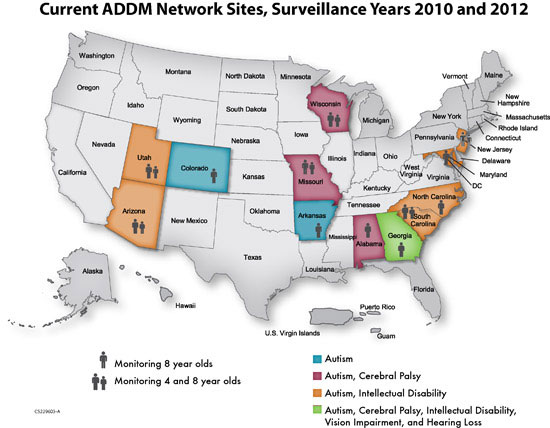Autism and Developmental Disabilities Monitoring (ADDM) Network
 The Autism and Developmental Disabilities Monitoring (ADDM) Network is a group of programs funded by CDC to estimate the number of children with autism spectrum disorders (ASDs) and other developmental disabilities living in different areas of the United States. The ADDM Network sites all collect data using the same methods, which are modeled after CDC's Metropolitan Atlanta Developmental Disabilities Surveillance Program (MADDSP).
The Autism and Developmental Disabilities Monitoring (ADDM) Network is a group of programs funded by CDC to estimate the number of children with autism spectrum disorders (ASDs) and other developmental disabilities living in different areas of the United States. The ADDM Network sites all collect data using the same methods, which are modeled after CDC's Metropolitan Atlanta Developmental Disabilities Surveillance Program (MADDSP).
ADDM Network goals are to:
- Provide data about how common ASDs are in a specific place and time period (also known as prevalence),
- Describe the population of children with ASDs,
- Compare how common ASDs are in different areas of the country,
- Identify changes in ASD occurrence over time, and
- Understand the impact of ASD and related conditions in US communities.
 Why is the ADDM Network Important?
Why is the ADDM Network Important?
Watch this video to learn more
What We’ve Learned
CDC estimates that about 1 in 88 children has been identified with an ASD. These estimates from the ADDM Network are based on data collected from health and special education records of children living in 14 areas of the United States during 2008. These 14 communities comprised over eight percent of the United States population of 8-year-olds in 2008. Information was collected on children who were 8 years old because previous work has shown that, by this age, most children with ASDs have been identified for services.
In 2007, CDC's ADDM Network first reported that about 1 in 150 children had an ASD (based on 2002 data from 14 communities). Then, in 2009, the ADDM Network reported that 1 in 110 children had an ASD (based on 2006 data from 11 communities). This means that the estimated prevalence of ASDs increased 23% during 2006 to 2008 and 78% during 2002 to 2008.

Here are the key findings from our most recent report:
- The number of children identified with ASDs varied widely across the 14 ADDM Network sites, from 1 in 47 to 1 in 210.
- More children were diagnosed at earlier ages—a growing number of them by age 3. Still, most children were not diagnosed until after they reached age 4.
- On average, diagnosis was a bit earlier for children with autistic disorder (4 years) than for children with the more broadly defined autism spectrum diagnoses (4 years, 5 months), and diagnosis was much later for children with Asperger disorder (6 years, 3 months).
- Almost 5 times as many boys were identified with ASDs than girls (1 in 54 compared to 1 in 252).
- White children were more likely than Black or Hispanic children to be identified as having ASDs, but the largest increases during 2002-2008 were among Hispanic children (110%) and Black children (91%).
- The majority (62%) of children identified as having ASDs did not have intellectual disability (intelligence quotient <=70).
Article: Prevalence of Autism Spectrum Disorders, 2008 »
Read the Community Report on the 2008 ADDM Network findings »
Article: Prevalence of Autism Spectrum Disorders, 2006 »
Read the Community Report on the 2006 ADDM Network findings »
Current ADDM Network Activities
- The ADDM Network is now in its 3rd phase of funding. Currently there are 12 ADDM Network sites monitoring the prevalence of ASDs among 8-year-old children living in these communities during 2010.
- CDC has also provided supplemental funding to six ADDM Network sites to monitor the prevalence of ASDs among younger children (4-year-olds) using ADDM Network methods. These efforts will increase our understanding of the characteristics and early identification of younger children with ASDs.
- Some ADDM Network sites also study the prevalence of other developmental disabilities, including cerebral palsy, intellectual disability, hearing loss, and vision impairment.

Read about the work taking place at each site by clicking one of the following links:
- Alabama
- Arizona
- Arkansas
- Colorado
- Georgia/CDC
- Maryland
- Missouri
- New Jersey
- North Carolina
- South Carolina
- Utah
- Wisconsin
Previous ADDM Network Activities
The ADDM Network's first phase included funding for 14 sites. These sites include the current phase list above plus three additional sites. Read about the work at each site by clicking one of the following links:
ADDM Network Publications
View a list of ADDM publications. To find other publications related to ASDs, visit our Articles page.
Contact Us:
- Centers for Disease Control and Prevention
National Center on Birth Defects and Developmental Disabilities
Division of Birth Defects and Developmental Disabilities
1600 Clifton Road
MS E-87
Atlanta, GA 30333 - 800-CDC-INFO
(800-232-4636)
TTY: (888) 232-6348
New Hours of Operation
8am-8pm ET/Monday-Friday
Closed Holidays - cdcinfo@cdc.gov



